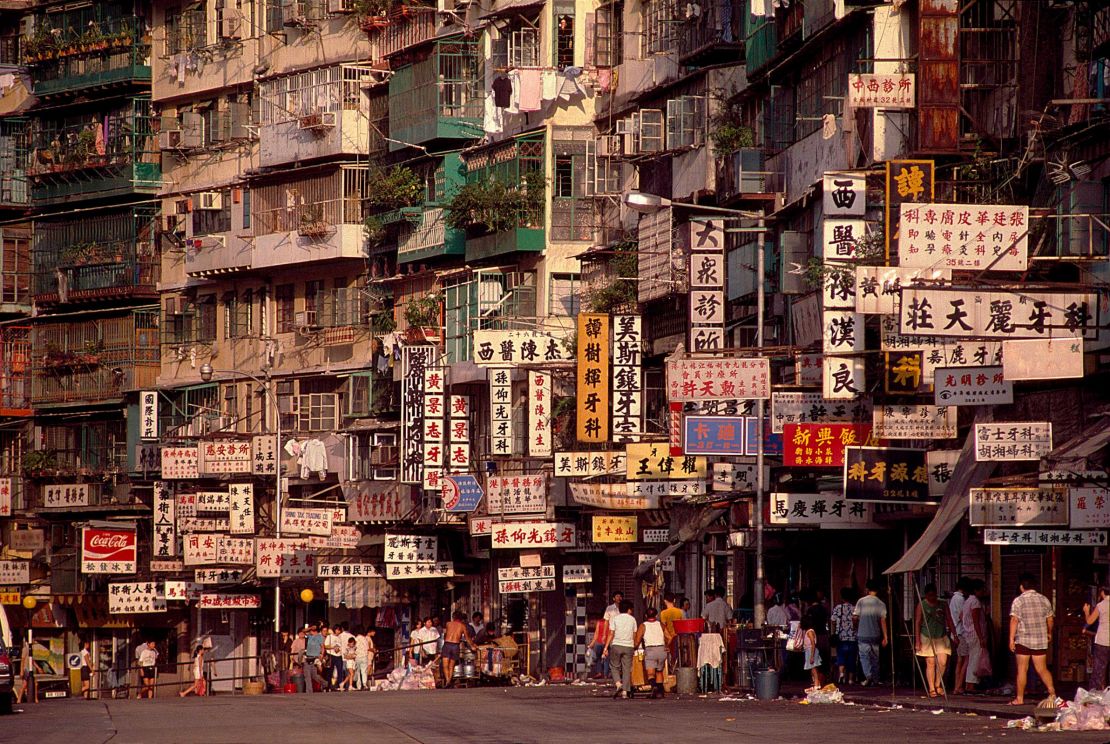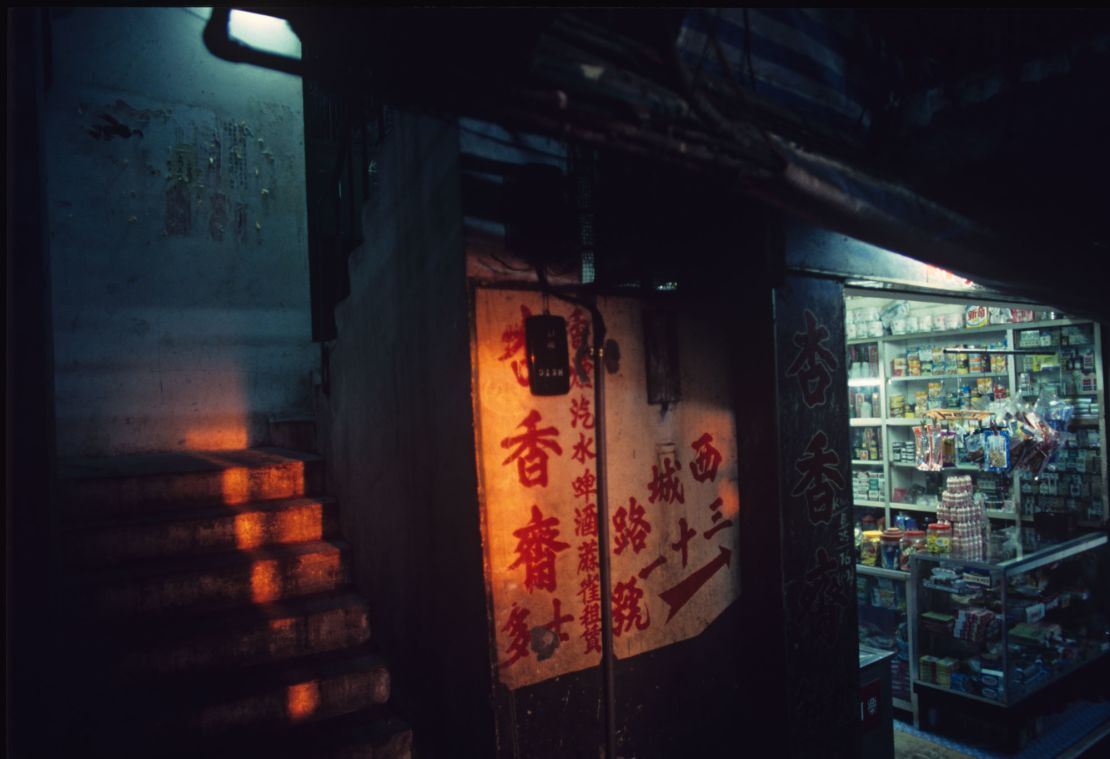Editor’s Note: In Snap, we look at the power of a single photograph, chronicling stories about how both modern and historical images have been made.
It was the summer of 1989. Hong Kong’s humidity – already oppressive – was intensified in the dark, maze-like alleyways of an unruly enclave known as Kowloon Walled City. Then the most densely populated place on Earth, its buildings were packed together so tightly that barely a slither of sky was visible from the ground.
Searching for a moment of respite from the heat and chaos below, photographer Greg Girard found himself on the roof of one of the enclave’s many illegally-built high-rises among a tangled thicket of television antennas.
He wasn’t alone. In the Walled City, the delineation of private and public spaces “wasn’t always so clear,” Girard recalled in a video call, adding that the roof was an escape for many of its residents to relax, do laundry or watch planes land at Kai Tak International Airport. “Once you get up to the rooftop, everything sort of changes. The vista opens up, and it’s cooler, there’s a breeze.”
Navigating the narrow gaps between buildings with planks of wood, children would skip and play between the webs of laundry lines and satellites. “No one seemed to think of it as a dangerous place, even though there were no guardrails or anything like that,” said Girard.
On that particular summer day, some children spotted Girard’s camera and approached him. When he turned the lens on them, they began performing and pulling faces. He snapped several shots, describing the final one, which he eventually chose to publish, as the moment when they had “settled into this face-off with me.”
In the photograph a young girl, barefoot and wearing a blue dress, stares into the camera. Her face is relaxed and her hands are wrapped around an antenna pole as if she’s about to swing. In the backdrop, her friend strikes a defiant stance, hands on her hips, while another is in the throes of messing around, bent double in a playful squat.
“I thought (the image) captured the kids’ indifference to the potential danger … of the rooftop, while at the same time sort of owning their territory and confronting me while goofing around,” said Girard, adding: “It was just quite an average day up on (there).”
The playfulness of the children, juxtaposed with the jagged antennas and stark concrete of their surroundings, seem to epitomized the spirit of Kowloon Walled City, the photographer said.
“It wasn’t an ideal playground but that never seemed to bother anyone — which was, of course, very much the spirit of the Walled City: making the best of, and even enjoying life in, a situation most other people would be horrified by.”

A ‘strange, vertical village’
Girard first visited Kowloon Walled City in 1986 while on a shoot at the nearby airport.
At that time, around 350 buildings, up to 14 stories high, were packed precariously into a space of 0.01 square miles. Most of the towers were built without proper foundations or regard for safety codes.
“This strange, vertical village wasn’t really supposed to exist,” said Girard, explaining the Kowloon Walled City was the product of a historical and political quirk. Although the enclave was situated in the middle of Hong Kong, then a British colony, imperial officials refused to take legal responsibility for it. As such, the Walled City remained technically subject to Chinese rule, though this was never enforced.
“That allowed it to become something you couldn’t have dreamed up,” Girard added.
Existing in ambiguity for nearly a century, it had a reputation for illicit dealings and was infamous for its triads, drug dens, brothels and unlicensed dentistry.
But by the time the Canadian photographer made his first visit to the “thriving” city in 1986, triad control had waned and these characterizations were, he said, “very out of date.”
“It might have been true at one time,” he added. But his enduring memory of the place was the community that lived there. “You quickly realize that it’s just a place where folks are trying to get by, like any other working-class part of Hong Kong.”
Girard was determined to demystify the so-called “City of Darkness,” particularly after the colonial government announced plans in 1987 to demolish it. He spent four years documenting the Walled City with fellow photographer Ian Lambot, with the pair eventually publishing a book of their images in 1999.
Early on, Girard decided to photograph the series in color and used portable lighting equipment — similar to the kind he used to capture celebrities and CEOs for glossy magazine portraits.
“The only pictures you saw of the Walled City at the time tended to be in black and white, and they made the place look as bad as possible, in keeping with the reputation of the Walled City as a dangerous, squalid slum,” said Girard. When it came to capturing people’s day-to-day lives, and images of residents, shopkeepers and factory owners, the photographer wanted to use “a more even-handed approach,” he added.
Girard documented, among much else, the blurred chaos of noodle and fish ball factories, a young child inspecting his grazed knee on the counter of his family’s grocery store, and a barber curling a client’s hair. While initial reactions to his presence were often frosty (“there was a palpable unwelcomeness to outsiders,” he recalled), residents eventually allowed him into their cramped apartments.
His guiding principle, Girard said, was “to try to show it for what it really was, since rumor and myths were the only things that were known about the place.”

Imagined dystopias
When the Walled City was razed, from 1993 to 1994, that was supposed to be the end of it. But in the decades since, the enclave has arguably garnered more interest than it ever did while standing. In 2014, Girard and Lambot published a “revisited” edition of their book that explored the city’s legacy in popular culture — including as an inspiration for fictional dystopias in video games and films, such as “Call of Duty: Black Ops” and “Batman Begins.”
“The Walled City was this jumping-off point for an imaginary city where the normal rules don’t apply,” said Girard.
There has been renewed interest in architectural circles, too: The unregulated, organic construction that made Kowloon Walled City a “dystopia” to live in is now being examined as a source of innovation due to its resourceful use of limited space and cheap or second-hand materials, said Girard.
“The limitations of that place certainly spurred a lot of creative responses, in building terms, to (the question of) what to do in a place that no one cares about, or pays attention to, except the residents,” Girard added.
The site of the Walled City has since been transformed into a public park, which opened in 1995. Quiet and uncrowded, it is in many ways the opposite of what it replaced, providing a much-needed reprieve from the clamor of a city desperately short on public space. Open-air chess pavilions and banyan-shaded ponds surround the old yamen building, a relic of the 19th-century Chinese garrison city that once stood on the site and the only structure to survive the demolition.
Inside the building, Girard’s famous rooftop photo is blown-up to fill an entire wall, accompanied by an audio track of children laughing and the roar of airplane engines. The memory of a vibrant community — immortalized by photographers like Girard — lingers.
Ongoing interest in the Walled City is, Girard suggests, because of the spirit it encapsulates: the aptitude for survival even in the harshest of circumstances. “It still continues to fascinate,” he said. “And that’s wonderful.”



